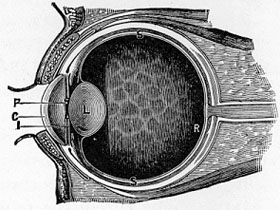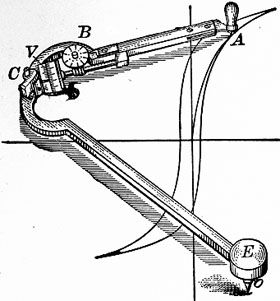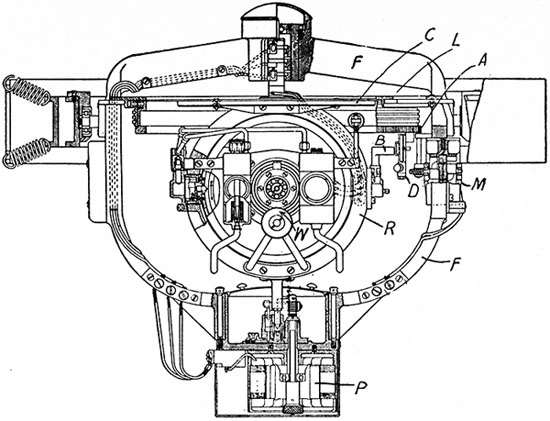Ervin S. Ferry
Today, the persistence of light. The University of Houston's College of Engineering presents this series about the machines that make our civilization run, and the people whose ingenuity created them.
We watch TV, or read by a fluorescent light, and images seem steady since the flickering light persists on our retina. According to the Ferry-Porter Law, the lowest frequency that seems steady is proportional to the log of light intensity. The brighter the light, the faster the flicker must be. That's why, back when computer screen refresh rates were slow, we eased eyestrain by dimming the screen.
I'd never heard of the Ferry-Porter Law when I picked up a 1918 book on Physics Measurements yesterday. It looks just like my old engineering textbooks. The author, Ervin Ferry, was born in 1868, studied science at Cornell, and did graduate work in Sweden. He joined the Purdue physics faculty in 1899. And he stayed.
Ferry's book is as ponderous as it is lucid. He practices an almost pathological predilection against pronouns. He loves beginning sentences with subordinate phrases. I'll read one of his sentences. Please try not to drive into a ditch while I do. He says:
Since the average value of those variable errors which tend to make a result too large will after a considerable number of measurements be about the same as the average value of those variable errors which tend to make the result too small, the mean of a large number of measurements is usually nearly free from variable errors.
That actually makes perfect sense if you can stand to stay with it.
 Ferry's writing loosens up when he gets to a section on the human eye. As he describes a laboratory model for the eye, he seems to find his comfort zone. Before he went to Purdue, he'd worked on vision. He formulated the Ferry-Porter Law in 1892. Ten years later Porter verified and refined Ferry's work.
Ferry's writing loosens up when he gets to a section on the human eye. As he describes a laboratory model for the eye, he seems to find his comfort zone. Before he went to Purdue, he'd worked on vision. He formulated the Ferry-Porter Law in 1892. Ten years later Porter verified and refined Ferry's work.
This book was his first in a series of beautifully illustrated and solid textbooks on what were really engineering subjects. By 1926, physics stood at the door of the quantum revolution, and Purdue was in trouble. The college dean wrote a report pointing out that Ferry was the only faculty member in physics who was publishing anything. Purdue finally had to hire a modern physicist out of Vienna to take them into the 20th century
 Ferry may've been closer to the old trade of military engineering. This instrumentation book was owned by one J. F. Kerr of Battery A -- probably someone in WW-I officer training. Ferry's later book on Applied Gyrodynamicssays a lot about the control of automobile torpedoes. That's a guided submarine torpedo. The word automobile, which means going by itself, was applied to these powered missiles long before we had motor cars.
Ferry may've been closer to the old trade of military engineering. This instrumentation book was owned by one J. F. Kerr of Battery A -- probably someone in WW-I officer training. Ferry's later book on Applied Gyrodynamicssays a lot about the control of automobile torpedoes. That's a guided submarine torpedo. The word automobile, which means going by itself, was applied to these powered missiles long before we had motor cars.
Ferry was certainly a creature of an earlier age, but he got the last laugh. Engineers and eye doctors alike know him -- if not by name, at least by the methods he honed for us. The next time I watch TV, do an experiment, or use image stabilization in my binoculars, I'll remember this 19th-century physicist-turned-engineer. With his celluloid collar, stiff formal prose, and illuminating pictures of instruments, he is with us still.
I'm John Lienhard, at the University of Houston, where we're interested in the way inventive minds work.
E. S. Ferry, A Handbook of Physics Measurements. (New York: John Wiley & Sons, Inc., 1918). The images of a human eye and of a planimeter above are from this source.
E. S. Ferry, Applied Gyrodynamics for Students, Engineers, and Users of Gyroscopic Apparatus. 1st Rev. Ed. (New York: John Wiley & Sons, Inc. 1933). The image of a Brown gyrocompass below is from this source.
E. S. Ferry, Persistence of Vision. American Journal of Science, July to Dec. 1892, pp. 192-207.
I'm grateful to Earl L. Smith, UH College of Optometry for his counsel, and to listener John McKee for pointing out that I've left room for misinterpretation in my wording above. McKee notes that the original automobile torpedoes were not equipped with such gyro-controlled systems as Ferry describes in his 1933 book. The switch from floating or rammed torpedoes, to ones that traveled under their own power, occurred in the latter 19th century. Guidance systems were not added until the early 20th century. Only in the 20th century did the automobile torpedo become an effective weapon
